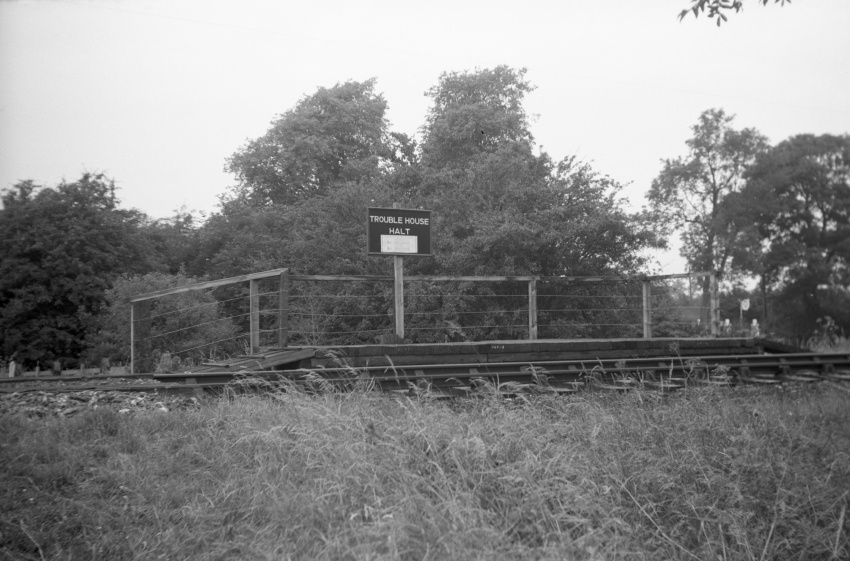Trouble House Halt
Gloucestershire
The circumstances surrounding the opening of this tiny station must surely be unique, at least for the time. Once located upon the 7¼-mile single-track branch line that linked Kemble with Tetbury, both in Gloucestershire, this timber-built halt — about half a BR Mk 1 carriage-length — was commissioned to serve a nearby historic inn. Naturally, it was from the latter which the halt took its name. The Trouble House Inn is located on the main road between Cirencester and Tetbury and, as recalled in The Birmingham Post on Saturday, 30th July 1960, a series of tragic incidents at the site dating from the 1600s onwards gave rise to the “Trouble” portion of the name. The inn also had the nickname Treble House, because the building was made up from three former cottages.
On Monday, 2nd February 1959, diesel railbus services commenced operation on Kemble to Tetbury and Kemble to Cirencester branch lines. Each four-wheeled railbus could accommodate forty-six seated passengers and, by the time the diesel service started, it was reported in local newspapers that twenty-two of these vehicles were in experimental use by British Railways (BR) on rural branch lines. Their introduction resulted in the commissioning of a series of then new timber halts on both Tetbury and Cirencester lines. On the former, Church’s Hill and Trouble House Halts were brought into use; on the latter, Chesterton Halt opened, followed on 4th January of the following year by the advent of a timber platform at Park Leaze.
The licensee of the Trouble House Inn at the time of the nearby halt’s opening was one Mr W. W. “Laddie” Pearce. The platform was situated on the opposite side of the road to the pub, the railway being located about 60-yards to the south east. A journey on the railbus from Tetbury to Trouble House was for a duration of five minutes and the distance between the stations was about two miles; the entire branch line, from the terminus to Kemble, was covered in twenty-four minutes. It can perhaps be considered remarkable that new stations on country branch lines were being opened at such a late stage. Indeed, this was the pre-Beeching era (only just), but stations and entire lines had already been closed post-1948, with others under consideration. The introduction of railbuses on these Gloucestershire branch lines and, of course, many others, formed part of the 1955 Modernisation Plan, which aimed to substantially reduce operating costs and mitigate heavy losses then being incurred by BR. When this failed to make a large enough impact, a draconian programme of closing entire lines and hundreds of stations became the order of the day. In March 1963, on the publishing of The Reshaping of British Railways report — authored by the former Chairman of chemicals firm ICI, Dr Richard Beeching — the Tetbury and Cirencester branch lines were listed amongst those proposed for closure. In the Gloucester Citizen newspaper on 11th June 1963, it was reported that notices informing the public of the proposed closure of Tetbury and Cirencester branches had been posted at local stations, and objections had to be submitted by 27th July of that year. The railbus timetable had not been enough to save the routes, and the branch lines from Kemble to Tetbury and Cirencester were closed on and from Monday, 6th April 1964.
What of the site of Trouble House Halt today? The timber platform is, unsurprisingly, long gone, but the track bed in the area is readily traceable, albeit under a sea of vegetation. Additionally, the station’s namesake, Trouble House Inn, is still trading on the main road. Are there any operational examples today of a railway station being dedicated to a public house or similar establishment? The closest to such a scenario your author can find is on the preserved Spa Valley Railway, where the line’s High Rocks station (1¼-miles west of Tunbridge Wells West) appears to be dedicated to an adjacent wedding venue and restaurant.
9th July 1959

The tiny timber platform of Trouble House Halt is seen during the year it opened. What appears to be a blank rectangle under the halt's name was actually a print out of the branch line's timetable. The main road and inn are situated behind the trees in the background. Left for Tetbury; right for Kemble. © David Glasspool Collection
Return to the Kent Rail Homepage or alternatively, check for Updates.
Website & Copyright information - Links - Contact the Webmaster
